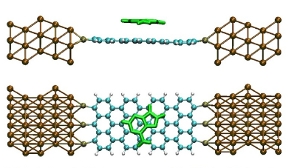Graphene as a good material for sensing single small molecules is hardly believed to identify bio-molecules via electrical currents. This is because bio-molecules tend to bind to graphene through non-covalent bonds, such as π-π stacking interaction, which is not customarily considered to induce a clear perturbation of the graphene electronic structure. In contrast to these expectations, we demonstrate that oxygen in nucleobases adsorbed on graphene with \u03c0-\u03c0 stacking interaction can clearly alter the electric current even in water at room temperature. This property allows us to devise the strategies employing graphene as material of choice in bio-sensorics, bio-chips.

Graphene as a good material for sensing single small molecules is hardly believed to identify bio-molecules via electrical currents. This is because bio-molecules tend to bind to graphene through non-covalent bonds, such as π-π stacking interaction, which is not customarily considered to induce a clear perturbation of the graphene electronic structure. In contrast to these expectations, we demonstrate that oxygen in nucleobases adsorbed on graphene with \u03c0-\u03c0 stacking interaction can clearly alter the electric current even in water at room temperature. This property allows us to devise the strategies employing graphene as material of choice in bio-sensorics, bio-chips.
